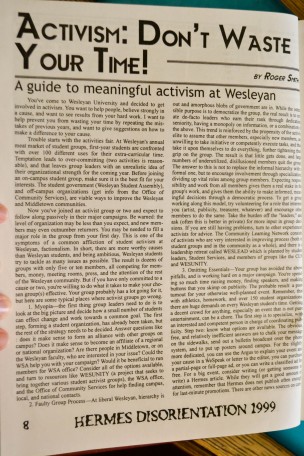
Prior to the start of the semester, two students published a DisOrientation guide, a 20-page document designed to present a narrative of important school issues to new students. The guide covers a range of topics, from trans* discrimination to labor issues on campus to divestment. The publication was available for download on the University Organizing Center (UOC) website beginning Thursday, Aug. 21.
Abby Cunniff ’17 spearheaded the project after finding similar guides made by students at universities such as UC Santa Cruz and Columbia. The publication had three editors—Cunniff, Claire Marshall ’17, and Amy Mattox ’17—as well as numerous contributors from a variety of activism-based student groups at the University.
“This is a way to connect the activist community, make it a little bit more like all of the groups are contributing to something,” Cunniff said. “Our goal is to present an alternative narrative to freshmen based on the experiences of people who have lived in our community….[The institution] can present their version of Wesleyan history, of Wesleyan activism, of what Wesleyan is and will be, but we want to present this other narrative so there’s room for you to [realize] not everything the institution says is fact.”
Cunniff said that one of her main goals was to help new students find their way in the activist community and avoid some of the problems she experienced during her first year.
“I struggled so much last year, and I don’t want [them] all to struggle,” Cunniff said. “I think that if I had figured out how these groups related to each other and had felt like there was a community of people working together, I would have felt a lot more secure and been more effective earlier.”
Marshall stressed that although the guide is called DisOrientation and was published shortly before the start of New Student Orientation, it was not written with only the Class of 2018 in mind; rather, it was intended for all students.
“This is a response to what our experience was, and the goal is very much to have something central and consolidated, simplified, so that a new student coming in or a current student that already knows Wesleyan but maybe doesn’t often get involved in these ways [has something] to pull it all together,” Marshall said. “It’s a whole community guide for all of Wesleyan, even extending to all of Middletown. There are lots of relevant things that go beyond incoming freshmen. This is a guide for everybody, by everybody.”
The most recent DisOrientation guide before this year’s was published at the University 15 years ago. Throughout the University’s past, DisOrientation has been produced in a variety of ways, most recently from 1982 to 1999 as the September issue of The Hermes. These editions focused on key issues at the time, such as gay rights, nuclear power, and divestment from South African companies in protest of Apartheid.
Previous DisOrientation guides covered several similar topics as the 2014 guide. The 1989 version discussed sexual assault at fraternities in depth, as does the current guide.
“Though an extremely high percentage of [sexual assaults] occur in fraternity houses or are perpetrated by fraternity members, some have argued that fraternities cannot be blamed for the actions of their individual members,” reads the Sept. 1, 1989 edition of The Hermes. “Yet the University, through its support of all-male fraternities (WSA funding), condones acts of harassment and intimidation when committed in the context of a fraternity function (such as a pledge ritual), and refuses to take effective action to punish offenders after it has been proven that an incident has occurred.”
The 2014 guide’s passage about sexual assault in regard to Greek life is similar in some respects.
“Over last spring break, President Roth sent out an email announcing the lawsuit against Psi U, and questioning ‘what role, if any, residential fraternities will have on our campus in the future,’” the disorientation guide reads. “The revelation that a student had been raped in the Psi U common room in public precipitated a tremendous wave of student outrage.”
Cunniff hopes to revive the disorientation tradition and continue producing guides in future years, building on the material from the current document.
“I’ve been emailing a lot of my professors asking for feedback on how we can improve the guide next year,” Cunniff said. “We’re definitely not using this as a stopping point…. We’re really hoping that we build on this model and continue it next year.”
Both Cunniff and Marshall stated that the general reaction to the guide has been positive. However, the editors have been contacted by parties expressing concern about new students feeling alienated by the narrative that the guide presents.
“One of our primary goals is to make it feel more inclusive and really emphasize that it is not only these groups that have set structures and set missions and aren’t open to change,” Marshall said. “It’s people, students, wanting to help and organizing in order to do so. It’s really so open to anyone who wants to contribute or has anything to give. We want everyone to feel that it’s a fluid space that can be anything. It’s only whatever we make it, and it’s a product of whoever is involved, and anyone can be involved.”
Cunniff further stressed that the guide is an important part of introducing new students to the activist community and is not meant to deter or discourage anyone from participating in any aspect of University life.
“I really love Wesleyan, and obviously I wouldn’t have put this much time and effort into [the guide] if I didn’t love Wesleyan, and I didn’t think that it could be so much better,” Cunniff said.


Leave a Reply